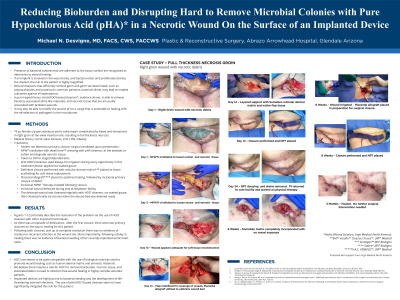Case Series/Study
(CS-053) Reducing Bioburden and Disrupting Biofilm with Hypochlorous Acid (HOCl)* in a Necrotic Wound in the Face of an Implantable Device

Biofilm and the bacterial burden have been recognized as impediments to wound progression.
Robson describes two components to biofilm: Polysaccharides and proteins. Polysaccharides which are long chains of simple sugars (monosaccharides) can be broken down by some liquids and may be the mechanism by which HOCl based wound cleansing solutions work.
Methods:
We present a case of HOCl helping to reduce bioburden and disrupt biofilm in a necrotic wound following full thickness necrosis following hematoma formation. The patient initially was not an operative candidate. From instillation to irrigation HOCK was used. Surgical closure was performed after debridement and following dehiscence. HOCL was again utilized as an irrigant prior to secondary closure. Following both closures, there was no evidence of residual or recurrent infection. More importantly, following a delay in healing there was no evidence of bacterial seeding of her recently implanted heart valve.
Results: We believe there may be a role for HOCl to assist reduction of biorburden and disruption of biofilm particularly in the face of an implantable device where seeding of the device with bacteria could result in limb or life threat.
Discussion:
We believe there may be a role for HOCl to assist reduction of biorburden and disruption of biofilm particularly in the face of an implantable device where seeding of the device with bacteria could result in limb or life threat. More data is needed however, there is a suggestion of potential use of HOCin the face on an implantable device.
Trademarked Items: *Vashe Wound Solution
References:

.png)